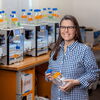A rising tide | A new Landing School program targets the composites sector
Now, the school says it plans to expand again in the fall of 2007 ˆ this time moving beyond its wooden boat-building niche and into the field of composite construction. This month, the school's board of trustees is expected to give the final go-ahead to a composites program that's been in the works for about a year. Like previous additions to the curriculum, the goal is to meet industry demands. Composites ˆ the most familiar being fiberglass ˆ were first developed following World War II. But since then, their use has grown far beyond the basic fiberglass construction into
more complex applications of carbon fibers, resins such as vinylester and other reinforcing materials. As those materials have grown increasingly complex, so have construction techniques and environmental concerns.
That shift has left a gap in the educational system and an industry yearning for properly trained employees, says Steve Dalzell, director of the Landing School's yacht design program and the faculty member in charge of creating the new composites program. "The vast majority of boats are now composite-built," Dalzell says. "As a school, I think we felt we weren't serving the big end of the industry."
While there are plenty of undergraduate and graduate programs that deal with composites in this country, including one at the University of Maine at Orono, they do so in a purely academic sense, Dalzell says. The Landing School's composite program is being designed in the mold of the school's existing programs, which offer students a hands-on experience. By the end of the 10-month course, according to the plan, students will have built a boat using composite materials. Dalzell says the program will be the first of its kind in the country, perhaps in the world.
With that kind of training, graduates would be a welcome addition to any company, say industry experts. Bob Lacovara, technical director for the Arlington, Va.-based American Composites Manufacturers Association, says the nationwide composite industry is a $24 billion business, employing 236,000. "Without a doubt there is a need for higher skilled employees and more employees," Lacovara says. "The graduates of this program will have good luck finding a job around the country."
On board
The addition of the composite program is the final piece of a $3 million expansion the school began six years ago with the development of its marine systems program. Getting the composites program off the ground will cost about $1.5 million, which includes the cost to demolish some existing buildings ˆ including the barn where it all began in 1978 ˆ and the construction of a new, two-story building designed to accommodate the new composites program and the wooden boat-building and yacht-design programs. The program is expected to increase the school's total number of students from 70 to 85, Dalzell says.
However, before considering the addition of the new program the school had to make sure there was demand for its potential graduates. Although the initial response to the program from boat builders within the state was "fiercely positive," Dalzell says, he still is a little bit wary. "Industry will often be positive, but they're not having to bet anything on it," he says. "It's quite an expensive game."
But people in the state's composite industry say there is more than enough demand for trained employees to ensure the success of the program. "As is the case in most trades in this country, there's just a very small and shrinking pool of apprentice craftspeople," says Cuyler Morris, president of Morris Yachts in Bass Harbor. An employee that comes to Morris Yachts already trained in composites would be worth 50% more than an untrained person, he adds. "There's a dire need for [trained employees] industry wide, not just in the state of Maine, but nationwide."
Stephen Von Vogt, chairman of the Maine Built Boats organization and founder of Portland-based Maine Marine Manufacturing, which is developing high-speed composite crafts with possible commercial and military applications, estimates that the boat building industry in Maine could absorb 200 to 300 more employees.
And while The Landing School's composite program will focus on boat building, the skills learned would be applicable to the wider composite industry, Dalzell says. Program graduates could end up working at companies such as Brunswick-based Harbor Technologies, which makes docks and pilings out of composite materials. "As far as composites are concerned, whether you're building boats or whether you build bridges or culverts or what have you, it's pretty much all similar stuff," says Martin Grimnes, president of Harbor Technologies and chairman of the Maine Composites Alliance, which has supported the creation of the program from the beginning.
Beyond just filling open positions, the program also could further growth in the state's composite industry, says Grimnes. More and better-trained composite workers could lead established companies to develop spin-offs in related industries, or even seed new companies. "I would imagine," he says, "some of these students entering the industry will open up doors for new opportunities in Maine."










Comments